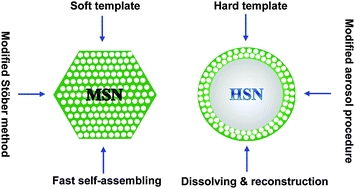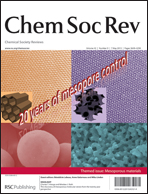Synthesis of mesoporous silica nanoparticles†
Abstract
Good control of the morphology, particle size, uniformity and dispersity of mesoporous silica nanoparticles (MSNs) is of increasing importance to their use in catalyst, adsorption, polymer filler, optical devices, bio-imaging, drug delivery, and biomedical applications. This review discusses different synthesis methodologies to prepare well-dispersed MSNs and hollow silica nanoparticles (HSNs) with tunable dimensions ranging from a few to hundreds of nanometers of different mesostructures. The methods include fast self-assembly, soft and hard templating, a modified Stöber method, dissolving–reconstruction and modified aerogel approaches. In practical applications, the MSNs prepared by these methods demonstrate good potential for use in high-performance catalysis, antireflection coating, transparent polymer–MSNs nanocomposites, drug-release and theranostic systems.

- This article is part of the themed collection: Mesoporous materials

 Please wait while we load your content...
Please wait while we load your content...